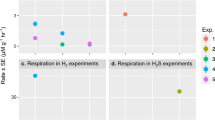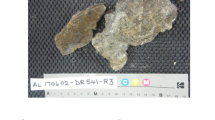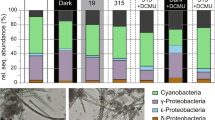Abstract
THE marine invertebrate Riftia pachyptila has a remarkable symbiosis with intracellular carbon-fixing sulphide-oxidizing bacteria which was first discovered at 2,450m depth on the Galapagos Rift1–4. Such symbiotic arrangements have since been found in a variety of invertebrate taxa and habitats5,6. Studies of these symbioses have focused on temperature, sulphide and oxygen as critical environmental parameters5,7–9. As Riftia has a high growth rate and its symbionts are far removed from the host surface10,11, inorganic carbon supply to the symbionts has been recognized as a problem and host mechanisms to concentrate inorganic carbon have been posited12,13. Increased environmental CO2 partial pressure (pCO2) has not seriously been considered as a critical environmental parameter7,14. Here we report that elevated pCO2 (2.9 kPa) in the worms' environment is a determinant of internal total CO2 (σ2CO2) and pCO2, facilitating CO2 transport and diffusion to the symbionts. We propose that elevated pCO2 is a potentially critical environmental factor for this species as well as for other chemoautotrophic symbioses.
This is a preview of subscription content, access via your institution
Access options
Subscribe to this journal
Receive 51 print issues and online access
$199.00 per year
only $3.90 per issue
Buy this article
- Purchase on Springer Link
- Instant access to full article PDF
Prices may be subject to local taxes which are calculated during checkout
Similar content being viewed by others
References
Corliss, J. B. et al. Science 203, 1073–1083 (1979).
Cavanaugh, C. M., Gardiner, S. L., Jones, M. L., Jannasch, H. W. & Waterbury, J. B. Science 213, 340–342 (1981).
Felbeck, H., Somero, G. N. & Childress, J. J. Nature 293, 291–293 (1981).
Felbeck, H. Science 213, 336–338 (1981).
Fisher, C. R. Crit. Rev. aquat. Sci. 2, 399–436 (1990).
Tunnicliffe, V. Oceanogr. mar. Biol. A. Rev. 29, 319–407 (1991).
Childress, J. J. & Fisher, C. R. Oceanogr. mar. Biol. A. Rev. 30, 337–441 (1992).
Fisher, C. R. et al. Deep Sea Res. 35, 1745–1758 (1988).
Johnson, K. S., Childress, J. J., Hessler, R. R., Sakamoto-Arnold, C. M. & Beehler, C. L. Deep Sea Res. 35, 1723–1744 (1988).
Arp, A. J. & Childress, J. J. Physiol. Zool. 58, 38–45 (1985).
Roux, M. et al. C. R. Acad. Sc. Paris (sér, III) 308, 121–127 (1989).
Felbeck, H. Physiol. Zool. 53, 272–281 (1985).
Childress, J. J. et al. Biol. Bull. 180, 135–153 (1991).
Fisher, C. R., Kennicutt II, M. C. & Brooks, J. M. Science 247, 1094–1096 (1990).
Raven, J. A. Can. J. Bot. 69, 908–924 (1991).
Jones, M. L. Proc. Biol. Soc. Wash. 93, 1295–1313 (1981).
Jones, M. L. Science 213, 333–336 (1981).
Arp, A. J., Childress, J. J. & Fisher, C. R. Jr, Bull. Biol. Soc. Wash. 6, 289–300 (1985)
Arp, A. J., Childress, J. J. & Vetter, R. D. J. exp. Biol. 128, 139–158 (1987).
Arp, A. J., Doyle, M. L., Di Cera, E. & Gill, S. J. Resp. Physiol. 80, 323–334 (1990).
Childress, J. J., Arp, A. J. & Fisher, C. R. Jr Mar. Biol. 83, 109–124 (1984).
Von Damm, K. L. A. Rev. Earth planet. Sci. 18, 173–204 (1990).
Johnson, K. S., Childress, J. J. & Beehler, C. L. Deep Sea Res. 35, 1711–1722 (1988).
Kochevar, R. E., Govind, N. S. & Childress, J. J. Molec. mar. Biol. Biotech. (in the press).
Rau, G. H. Bull. Biol. Soc. Wash. 6, 243–248 (1985).
Van Dover, C. L. & Fry, B. Mar. Biol. 102, 257–263 (1989).
Mook, W. G., Bommerson, J. C. & Staverman, W. H. Earth planet. Sci. Lett. 22, 169–176 (1974).
Childress, J. J., Fisher, C. R., Favuzzi, J. A. & Sanders, N. K. Physiol. Zool. 64, 1444–1470 (1991).
Quetin, L. B. & Childress, J. J. Deep Sea Res. 27, 383–391 (1980).
Boutilier, R. G., Heming, T. A. & Iwama, G. K. in Fish Physiology (eds Hoar, W. S. & Randall, D. J.) 401–430 (Academic, New York, 1984).
Author information
Authors and Affiliations
Rights and permissions
About this article
Cite this article
Childress, J., Lee, R., Sanders, N. et al. Inorganic carbon uptake in hydrothermal vent tubeworms facilitated by high environmental pC02. Nature 362, 147–149 (1993). https://doi.org/10.1038/362147a0
Received:
Accepted:
Issue Date:
DOI: https://doi.org/10.1038/362147a0
This article is cited by
-
Discovery of a readily heterologously expressed Rubisco from the deep sea with potential for CO2 capture
Bioresources and Bioprocessing (2021)
-
Exploring the oxygenase function of Form II Rubisco for production of glycolate from CO2
AMB Express (2021)
-
Specialized adaptations allow vent-endemic crabs (Xenograpsus testudinatus) to thrive under extreme environmental hypercapnia
Scientific Reports (2020)
-
Heavy Metal Bioaccumulation in the Anemone Paraphelliactis pabista Dunn, 1982 (Actiniaria: Hormathiidae) from the Hydrothermal System of Guaymas Basin, Gulf of California
Bulletin of Environmental Contamination and Toxicology (2019)
-
Dissolved inorganic carbon uptake in Thiomicrospira crunogena XCL-2 is Δp- and ATP-sensitive and enhances RubisCO-mediated carbon fixation
Archives of Microbiology (2016)
Comments
By submitting a comment you agree to abide by our Terms and Community Guidelines. If you find something abusive or that does not comply with our terms or guidelines please flag it as inappropriate.



